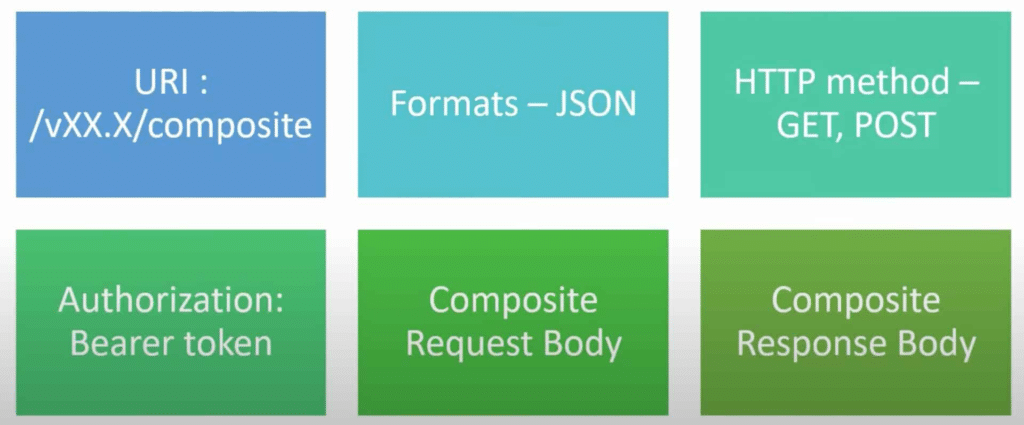Salesforce Composite API: Salesforce is a massive player in the ever-changing customer relationship management (CRM) space, offering organizations powerful tools to optimize their processes. The Salesforce Composite API is one of the essential elements that enables this effectiveness. We will go into the details of the Composite API in this blog article, examining how it transforms data integration, streamlines intricate processes, and improves Salesforce’s overall usefulness.

In web services and software development, a Salesforce composite API is an API (Application Programming Interface) that combines and unifies several distinct APIs and services into a cohesive interface. By offering a higher-level interface that integrates the functionality of numerous services, a composite API seeks to simplify and expedite interactions with multiple underlying APIs.
Comprehending the Salesforce Composite API: One of the Salesforce platform’s most valuable features is the Composite API, which enables administrators and developers to do several tasks with only one call. This method enhances efficiency and lowers the possibility of mistakes by drastically lowering the quantity of API requests.
Table of Contents
ToggleEssential Features of Salesforce Composite API

Aggregation: Salesforce Composite APIs combine services from many endpoints or sources. They can compile data from several APIs into a single resource or answer. Thus, you can obtain the information from the Account and the associated Contacts with only one API call.
Orchestration: These APIs frequently use intricate workflows and logic to coordinate requests and responses from the underlying APIs. They may use data transformation, conditional branching, and other orchestration techniques to accomplish a specific goal or job. It is possible to use an external field to find an Account and then use that Account to create a contact.
Simplification: Simplifying the interaction with a collection of APIs is the primary goal of Salesforce composite APIs. Developers can submit a single request to the composite API, which handles the underlying complexity, saving them from having to handle complicated coordination and several calls. Composite API is the best option if you want to create an account, a person’s name, language, a contact point phone number, and a contact point consent all at once.
Security and Authentication: Salesforce Composite APIs frequently take care of the underlying APIs’ authorization and authentication, making sure that users and apps are authorized to access the combined resources. Individual authentication for every internal API is optional. The composite API itself handles that.
Salesforce Composite APIs are handy when apps need to communicate with several different services or data sources to complete a given activity. Microservices architectures frequently employ them, wherein distinct microservices offer particular functionality, and a composite API merges these microservices to provide clients with a higher-level service.
Overall, by reducing the complexity of interacting with numerous APIs and services, composite APIs assist developers in creating applications that are more effective, scalable, and user-friendly.
Composite: Returns a list of additional composite resources with a GET request or executes many REST API calls in a single POST request. Use Composite to Send Many Requests.
Carries out several REST API calls in a single call: One request’s output might be input for another request later. One response body contains both the HTTP statuses of the requests and the response bodies. Regarding your API restrictions, the sequence of requests as a whole counts as one call.
Obtain a Composite Resources List: Obtains a list of other composite resource URIs.
What is meant by a composite resource?

The composite resource is a unique kind of REST API resource that combines several requests into one. It can carry out sophisticated logic that requires several steps, obtain data from numerous objects, and conduct CRUD operations on multiple records. Composite and Composite are the two subresources that make up the composite resource.
In a single call, the composite subresource completes several REST API requests. By employing reference IDs, the output of one request can be utilized as the input for another. One response body contains both the HTTP statuses of the requests and the response bodies. A call to the composite subresource can accommodate up to 25 subrequests.
In a single call, the composite subresource performs several CRUD actions on several connected sObjects. The subrequests are arranged into graphs, each showing a group of related sObjects. The coordination of the relationships and the efficient atomic processing of the records are handled by the composite subresource. A call to the composite subresource can accommodate 500 subrequests.
How does an aggregated resource function?
To access the composite resource, you must submit a POST request in the API version. An array of subrequests, each including the method, URL, referenced, and body (if applicable) of a separate REST API request, should be contained in the request body. Here’s an example of a straightforward composite request that establishes a contact and an account:

The response body will include various results, all of which correlate to the subrequest in the same order. The reference Id, HTTP status code, and body (if relevant) fields will be present in each result. For instance, the following is the answer to the earlier request:

What applications does the composite resource have?
In many situations, the composite resource might be helpful when making several REST API calls in one call. Here are a few instances:
Bulk data loading: To reduce the number of API calls and enhance efficiency, insert, edit, or remove several entries in a single call using the composite resource.
Data synchronization: Salesforce and an external system, like a web service or mobile app, can synchronise their data using the composite resource. Reference IDs can be used to connect interdependent entries, like parent-child connections.
Complex logic: The composite resource can carry out multi-step, complex logic operations like opening a case, adding it to a queue, and sending an email alert. Reference IDs can transfer data between subrequests, like email addresses or case IDs.
Benefits of the Salesforce Composite API
Increased Performance: By reducing the number of network requests, the Composite API lowers latency and boosts overall performance. Multiple actions can be combined into a single request to expedite data processing and conserve precious server resources.
Atomicity and Consistency: The Composite API guarantees atomicity, which is the condition that every operation in a request is completed successfully or not at all. This protects your Salesforce database from inconsistent or partial updates by ensuring data consistency and integrity.
Increased Developer Productivity: Developers may do more with fewer API calls when they use the Composite API. By taking a more efficient approach, you can focus on creating reliable apps by streamlining the coding process, lowering complexity, and increasing development productivity.
Decreased API Consumption: The Composite API lets you do several tasks with a single request, so you can cut down on the amount of API calls you make. This helps save costs, especially for businesses that need to use a lot of APIs.
Transaction Control: Using the Salesforce Composite API’s transactional control feature, you can perform every action in a request as a single transaction. This implies that you can preserve data consistency and integrity by rolling back changes if a transactional mistake arises.
The Best Ways to Use the Salesforce Composite API
Sequential Tasks: When utilising the Composite API, it is essential to bundle related activities (e.g., generating or changing many records of the same object). This method increases efficiency and reduces the amount of API queries.
Error Handling: To successfully collect and handle errors, implement strong
Error handling systems: You can detect and address issues at the level of individual operations with the help of the sub-responses included in the Composite API response for each action.
Governor Limits Examination: Although API consumption is optimized using the Composite API, Salesforce’s governor limits must be considered. To prevent reaching those restrictions, be aware of the limitations of various operations and adjust your requests appropriately.
Performance Optimization: Reduce superfluous data transfer by carefully choosing which information to retrieve in your requests. To further improve performance, consider asynchronous processing for tasks that don’t need to be completed immediately.
Throttling and Backoff Strategy: Be aware of Salesforce’s API rate limitations to avoid throttling. When API restrictions are reached, use a backoff approach to handle the situation so your application may automatically retry after a predetermined time.
In summary
You may optimize your REST API requests to Salesforce with the help of the composite resource, which is a vital tool. It saves you time and bandwidth by enabling you to process several requests in a single call. In addition, it maintains the atomicity of operations and coordinates relevant records.
The composite resource can carry out sophisticated logic that requires several steps, get data from numerous objects, and conduct CRUD actions on multiple records.




